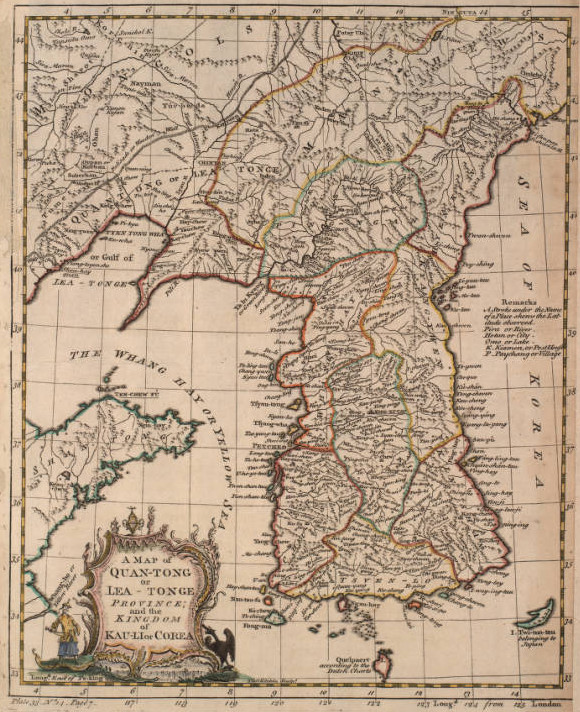From Joseon to Korea
Origins of the various names of Korea
One of the first things I noticed after learning Hangul is that Koreans don’t call their country Korea in their own language. South Koreans call it Hanguk (한국) while North Koreans use the word Joseon (조선). Why is that? And where does the name Korea come from? In this post we’ll go back in time to answer these questions.
Joseon (조선) was the name of Korea’s founding state which is believed to have ruled over the Korean peninsula and a good part of Manchuria during the last two millenia BC, until it fell to China around 100 BC and broke into many small kingdoms. Over a thousand years later, at the end of the 13th century, the name was revived to create the Joseon dynasty, which ruled until the beginning of the 20th century when it was invaded by Japan. The old Joseon is now called Gojoseon (고조선) to avoid confusion (“Go” standing for “Ancient”).
In 1897, the Joseon kingdom decided they were now an empire and shall be called Daehan Jeguk (대한제국). Although it’s a bit unclear to me what Han (한) stands for, we know it was chosen in reference to three confederations of city-states collectively called Samhan (삼한, Three Hans), which ruled over the peninsula after the fall of Gojoseon. If you’ve heard of the Three Kingdoms of Korea, well that’s not it. These ones come just before, and are usually referred to as Proto-Three Kingdoms of Korea. Dae (대) stands for great, Jeguk (제국) means empire, so Daehan Jeguk was the Great Empire of Han. This empire didn’t last long as it was annexed by Japan in 1910. The name of the country was then reverted to Joseon.
During the Japanese occupation, which lasted until Japan lost the war in 1945, the two names Joseon and Han coexisted. When Korea was divided after gaining its independence, the North named their state Joseon Minjujuui Inmin Gonghwaguk (조선민주주의인민공화국), the Democratic People’s Republic of Korea. They now still use the word Joseon to refer to Korea as a whole. Meanwhile the South went with Han, calling their state Daehan Minguk (대한민국), the Great Republic of Han, also known as Republic of Korea. The contraction of Daehan Minguk is Hanguk (한국), which is now used by South Koreans to refer to South Korea in their daily life. They call North Korea Bukhan (북한), Buk standing for North.
As you can see Joseon (North) and Hanguk (South) are both names rooted in history, although they are based on different eras. But we still haven’t explained where the name Korea came from...
For that, we have to look at what came between Samhan and Joseon. As I said, after Samhan came the Three Kingdoms of Korea: Goguryeo (고구려), Baekje (백제), Silla (신라). These kingdoms ruled roughly during the first millennium AD. After them came Goryeo (고려), which ruled over the whole peninsula until it was replaced by Joseon in 1392.
So we have a Korean kingdom named Goryeo, ruling from 918 to 1392, which happens to also be the time of the expansion of the great Mongol Empire, started by Genghis Khan around 1200 1. On one hand, these Mongol conquests were an immense human tragedy that caused the death of millions of people. On the other end, they brought political stability throughout the Asian continent and allowed trade between the West and East to take place through the Silk Road.
It’s from these contacts between Goryeo and the West that came the word Korea. At the end of the 13th century, Marco Polo mentions Goryeo in his writings as Cauli, transcribed from the Chinese Gaoli (高麗). Whether or not Marco Polo actually went to China is debated, but the popularity of his book can’t be denied.
Over the centuries, Cauli became Kauli, Corea, Korea or in French, Corée. To illustrate this evolution, I found a very interesting map in the digital library of the University of South California. This map is from the 18th century and was reproduced in several languages. The English version above mentions the “kingdom of Kauli or Corea”. The French version writes it “royaume de Kauli ou Corée”. And here is another French version with Dutch annotations at the bottom where you can read “koningryk Kauli of Korea”.
And that concludes our exploration of Korea’s various names, I hope you enjoyed it! We went from the founding state, Joseon, the name of which is still in use in North Korea, to Hanguk, the modern name for South Korea which is also rooted in history. We also saw how the old state of Goryeo gave birth to the Western name Korea.
- If you’re interested in the Mongol conquests, I strongly recommend you check out the audio series Wrath of the Khans from Dan Carlin’s Hardcore History podcast. It’s a-ma-zing. ⏎
